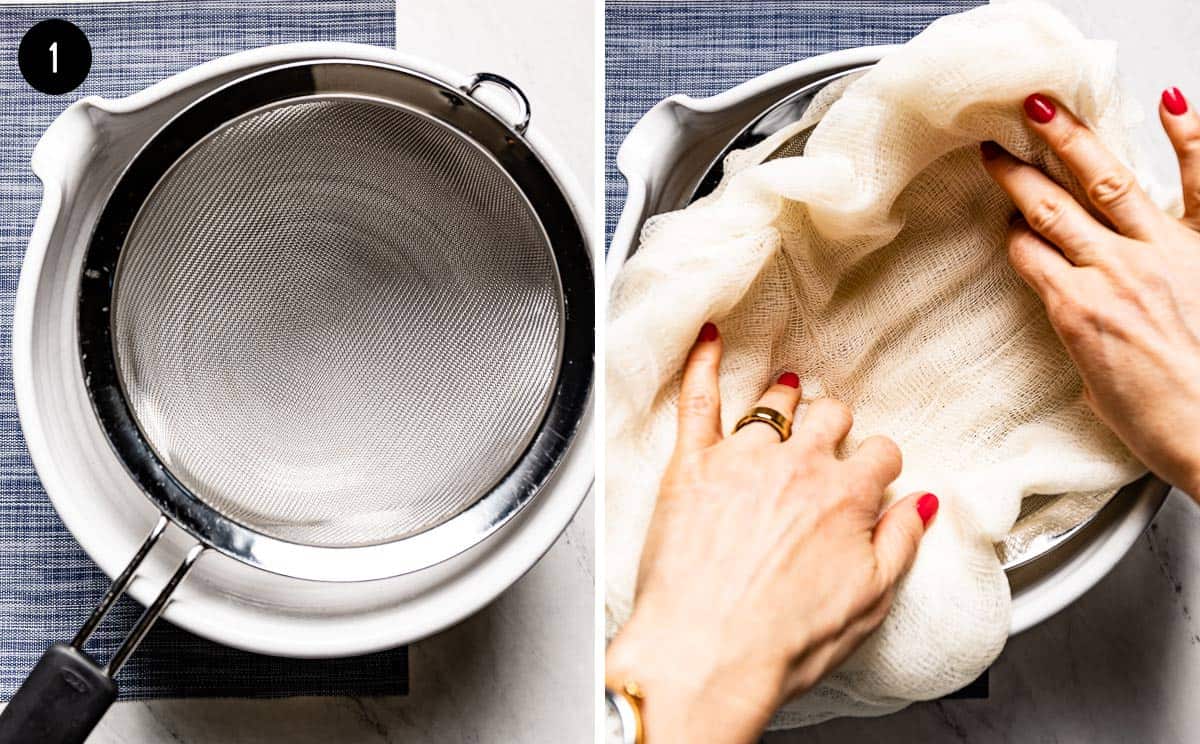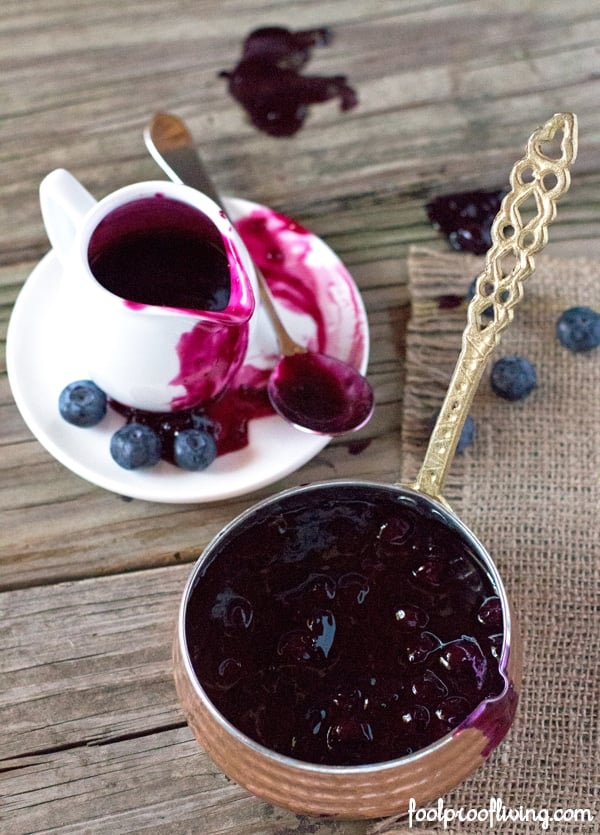Ricotta is a classic Italian cheese that is so easy to make at home. Although you can buy an authentic artisanal variety at the closest old-school Italian market, you can make ricotta cheese at home from scratch with a little bit of time and patience.
The best part – this easy homemade ricotta cheese recipe can be used in savory recipes like eggplant involtini, ricotta lemon pasta or strawberry ricotta bruschetta or sweet recipes like almond flour ricotta cake or lemon ricotta pancakes. Just as the Barefoot Contessa says, “how easy is that?”

Ingredients
The ricotta cheese ingredients are short and sweet – all you need is:
- Whole cow milk
- Heavy cream
- Kosher salt
- White wine vinegar

Ingredient Substitutions and Notes
- Milk and Cream: If you can get your hands on them, look for milk and cream at the grocery store that is pasteurized. While ultra-pasteurized milk and heavy cream work in this easy ricotta recipe, I find that the pasteurized variety yields creamier results.
- Vinegar: Feel free to use distilled white vinegar or lemon juice instead.
How to Make Ricotta Cheese At Home
DIY ricotta is as easy as it comes and will always outrank the regular grocery store variety. Here’s how to make ricotta cheese from scratch in your very own kitchen. Follow these simple steps for perfect results:

- Prep equipment: Place a fine-mesh large sieve over a deep bowl (deeper and larger than the sieve) and line it with 2 layers of cheesecloth. Set aside.

- Boil milk and cream: Pour the milk, cream, and salt into a large nonreactive saucepan like a Dutch oven (or any other heavy-bottomed saucepan). Stirring occasionally, heat the mixture over medium heat until it comes to a full boil (about 15 to 20 minutes) or the whey is heated to 185 degrees.
- Add vinegar: Turn off the heat and slowly add the vinegar. Gently stir it once and let it sit undisturbed for 3 minutes. It will instantly start to curdle.

- Separate the curds from the whey: Pour the mixture into a cheesecloth-lined sieve and let the mixture drain into the bowl for at least 1 hour (or up to 2 hours). Do not discard the leftover whey (more on that below). The longer you let the mixture drain the thicker it will get. I like mine after an hour. However, you can let it drain in the fridge overnight as well, especially if you like your fresh ricotta cheese on the thicker side.

- Use and store: Transfer ricotta to a bowl. Use immediately or transfer to an airtight container and refrigerate. The ricotta cheese will last for 4-5 days in the fridge.
How to Serve
Ricotta can be reheated without melting, making it a great option for filled pasta recipes like ravioli, manicotti, or lasagna and baked goods like cannoli and cheesecake. Here are a few ideas and fresh ricotta cheese recipes to inspire you. Serve it as:
- Spread: Slather it on toast with a drizzle of olive oil and sea salt or make a sweet version with fresh fruit like fresh figs or summer-time stone fruit. Or, go all out and use it in Bruschetta recipes like this Butternut Squash Bruschetta or Herbed Ricotta Bruschettas.
- Dip: Use this basic recipe and when ready, stir in some fresh herbs, lemon zest, red pepper flakes, black pepper, garlic, and olive oil for a creamy dip that goes best with fresh-cut vegetables. Herbed ricotta can be an excellent addition to your holiday meat and cheese platter.
- Pasta: Stuff or drop a large dollop of the ricotta into any and all pasta recipes, including roasted eggplant baked ziti, mushroom and pea pasta, roasted shrimp and kale rigatoni, or baked ziti with meat sauce.
- Baked Goods: Transform fresh ricotta cheese into savory heirloom tomato tart or sweet mini lemon tarts.
How to Store
This delicious homemade ricotta cheese will keep in an airtight container or covered with plastic wrap in the fridge for up to 5 days.
I do not recommend freezing the ricotta.
Expert Tips:
- Use half as much cream as milk. Too much heavy cream will weigh down your ricotta, making it less fluffy.
- Use an enameled pot. I like to use my Le Creuset (or Staub) Dutch oven.
- Use an instant-read thermometer if you can. You can add the vinegar as soon as the milk and cream mixture comes to a boil. However, for perfect results, use an instant-read thermometer to ensure that it reaches 185 degrees F. (85 C.)
- Drain the ricotta well. The longer and more thoroughly you drain your ricotta, the thicker it will be. It tastes best when it is at room temperature.
- Don’t overmake. Homemade fresh ricotta goes bad quickly, so it is best to make only the amount you will use in the next few days. If you need to scale up the recipe, one gallon (16 cups) of a combo of milk and cream will yield approximately one pound of cheese.
- Resist the urge to stir it too much. It is best to let it do its thing.
- Don’t throw away the remaining whey (milky parts). It’s full of nutrients and good bacteria. You can add a little to the soaking liquid for grains, make pizza dough, use it in smoothies, or pour a touch in when marinating meats.
FAQs
Here are a few FAQs and troubleshooting to help you as you make fresh ricotta at home.
Ricotta cheese is an Italian cheese made from whole milk, heavy cream, vinegar and salt. The word ricotta means “recooked” in Italian. However, ricotta is considered a “whey cheese.”
When making ricotta, use the freshest milk and cream you can find and avoid ultra-pasteurized, if you can.
This fresh ricotta recipe is highly perishable. Store it in an airtight container for up to 4-5 days in the fridge.
Heating the milk too quickly will create a less smooth, creamy texture. Keep it over medium heat and be patient – the milk will eventually come to a boil.
If the ricotta is stirred too much while the curds are forming (i.e. after you add the vinegar), it will cause the curds to seize up and become rubbery.
It depends on your recipe. However, since they are both reduced milk products in most recipes yogurt could be a good substitute for ricotta cheese.
While they are very similar in the ingredients used to make them, ricotta is different than cottage cheese, mainly in texture. They are both spreadable cheeses. Ricotta cheese tends to be smooth with a grainy texture, while cottage cheese has a lumpier texture.
Yes, long as it is consumed in moderation. Ricotta cheese is a good source of calcium and protein and contains all nine essential amino acids, according to this Ricotta Cheese article.
Why Should You Try This Recipe?
This homemade ricotta recipe delivers a luscious and creamy cheese that you can use in many recipes. But that is not the only reason why it is worth your time. Here are a few more reasons:
- All it takes is 4 ingredients: Milk and cream are the stars of the show, so make sure to buy the freshest ingredients you can find.
- You can adjust the consistency to your liking: Keep it moist or really thicken it; the choice is up to you. This fresh cheese is supposed to have a creamy consistency, but if you prefer it to be thicker, you can easily adjust the draining time and get the results you are after.
- Serving is super versatile: Its light flavor pairs well with both sweet and savory dishes, and its fluffy texture makes your baked goods that much more enjoyable.
More Barefoot Contessa Recipes You Might Also Like:
- Chicken Stock
- Pot Roast
- Peanut Butter Chocolate Globs
- Chicken with Basil and Goat Cheese (One of the most popular recipes among all of my Goat Cheese Recipes)
- Roasted Butternut Squash Salad
If you try this Homemade Ricotta Cheese recipe or any other recipe on Foolproof Living, please take a minute to rate the recipe and leave a comment below. It helps other readers who are thinking of making the recipe. And if you took some pictures, be sure to share them on Instagram using #foolproofeats so I can share them on my stories.

Ricotta Cheese Recipe
Ingredients
- 4 cups whole milk, Pasteurized not Ultra pasteurized
- 2 cups heavy cream
- 1 teaspoon kosher salt
- 3 tablespoons white wine vinegar, or distilled vinegar
Instructions
- Place a colander over a large pot (deeper and larger than the colander) and line it with 2 layers of cheesecloth. Set aside.
- Pour the milk, cream, and salt in a large nonreactive saucepan like a Dutch oven. Stirring occasionally, heat the mixture in medium heat until it fully boils or it reaches to 185 degrees.
- Turn off the heat and slowly add the vinegar. Gently stir it once and let it sit undisturbed for 3 minutes.
- You will see it getting curdled.
- Pour the mixture into the colander lined with cheesecloth and let it drain for at least an hour (or more like 2 hours). The longer you strain the thicker it will get. I like mine after an hour.
- You can either use immediately or transfer it in an airtight container and refrigerate.
Notes
- This recipe makes about 2 cups of ricotta cheese. The amount may change depending on how long you let it drain. The longer it drains, the thicker it will become.
- Don’t throw away the remaining whey (milky parts). It’s full of nutrients and good bacteria. You can add a little to the soaking liquid for grains, making pizza dough, use it in smoothies, or pour a touch in when marinating meats.
- Storage: Homemade ricotta cheese has a rather short shelflife but as long as it is kept in an airtight container in the fridge, it should be fresh for up to 5 days.
Nutrition
Nutrition information is automatically calculated, so should only be used as an approximation.

Adapted from Ina Gartens’ “Barefoot Contessa, How Easy Is That?” cookbook, Homemade Ricotta Cheese (page-74) and Herbed Ricotta Bruschettas (page-73).















It was so easy that it´s hard to believe! I had to add a bit more vinegar for the curds to appear.
Happy to hear that Mafe.
Thanks for coming by!
Perfection !
After several attempt, this is the recipe to follow.
I read the reviews as I always used lemon juice, that’s why it never worked.
Used vinegar and it worked. So creamy. Thank you.
This is music to my ears Cathy. Thanks for coming by.
Please help. I have made ricotta this way many times. However, there were a couple times I had to throw it out because it simply would not curdle after i added vinegar. I can’t figure out why this would happen. My technique was always same but results were not
Interesting.. I have never had that issue. In the past, I have also made and saw some success with Anne Burrell’s version She adds the vinegar at the beginning instead of later.
Why not give that recipe a try and see if it works?
I hope this helps.
It just happened to me, too. Turns out my milk was Ultra-pasteurized. I didn’t even realize I was always buying Ultra-pasteurized milk.
My hunch is that’s what happened to you, too.
Awesome!
Oh my gosh, that looks so creamy and delicious!